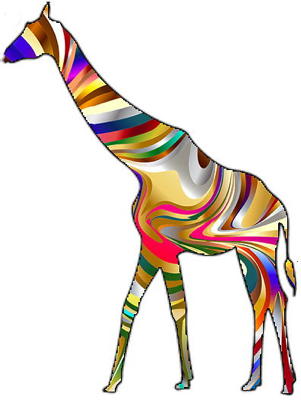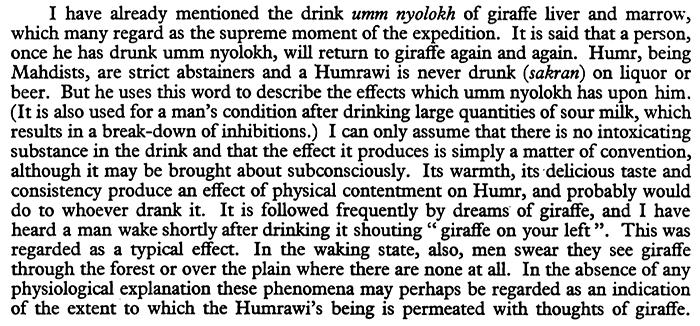Hallucinogenic giraffe livers
It's possible that the livers of some giraffes might be hallucinogenic when consumed. Although the claim is controversial.

The idea was first introduced into the scientific literature in 1958 by anthropologist Ian Cunnison, in an article published in the obscure journal Sudan Notes and Records.
Cunnison had spent time with the giraffe-hunting Humr tribe of Sudan, and he reported that after a successful hunt they would often consume a drink called umm nyolokh made from the liver and bone marrow of the giraffe. Cunnison didn't try the drink himself, but its effects, as described to him by the Humr, seemed to be hallucinogenic, Here's the relevant passage in Cunnison's article:

It's noted on Wikipedia that, if the reports from the Humr were accurate, “this claim would make the giraffe the first mammal to be discovered to contain a hallucinogen in its bodily tissues,” However, Cunnison himself was skeptical, suggesting that the perceived effects might be “brought about subconsciously.”
Cunnison’s article didn’t attract much attention until 1998, when Richard Rudgely discussed it in his Encyclopedia of Psychoactive Substances. Rudgely was far more willing to believe that the giraffe livers really were hallucinogenic.
Since then people have speculated that the giraffes in Sudan might have been consuming plants, such as Acacia trees, that contained psychoactive substances, which then concentrated in their livers.
But to date, to my knowledge, the issue remains entirely speculative because no one has gone to Sudan to find and test some of this umm nyolokh.


The idea was first introduced into the scientific literature in 1958 by anthropologist Ian Cunnison, in an article published in the obscure journal Sudan Notes and Records.
Cunnison had spent time with the giraffe-hunting Humr tribe of Sudan, and he reported that after a successful hunt they would often consume a drink called umm nyolokh made from the liver and bone marrow of the giraffe. Cunnison didn't try the drink himself, but its effects, as described to him by the Humr, seemed to be hallucinogenic, Here's the relevant passage in Cunnison's article:

It's noted on Wikipedia that, if the reports from the Humr were accurate, “this claim would make the giraffe the first mammal to be discovered to contain a hallucinogen in its bodily tissues,” However, Cunnison himself was skeptical, suggesting that the perceived effects might be “brought about subconsciously.”
Cunnison’s article didn’t attract much attention until 1998, when Richard Rudgely discussed it in his Encyclopedia of Psychoactive Substances. Rudgely was far more willing to believe that the giraffe livers really were hallucinogenic.
Since then people have speculated that the giraffes in Sudan might have been consuming plants, such as Acacia trees, that contained psychoactive substances, which then concentrated in their livers.
But to date, to my knowledge, the issue remains entirely speculative because no one has gone to Sudan to find and test some of this umm nyolokh.

Members of the Humr tribe skinning a giraffe after a hunt.
Source: Sudan Notes and Records
Comments
You realize that now the giraffes are going to go the way of the Rhino, and it'll be your fault!
Posted by mjbird on 09/11/19 at 03:10 PM
Effing barbarians. Killing giraffes.
Posted by Virtual in Carnate on 09/11/19 at 03:37 PM
On a side note, it's crazy the lenght to which the Humr will go not to say they drink alcohol. "No, I swear, it's not Kumis, it's just sour milk. It just makes me mellow somehow. Must be the power of the giraffe."
Posted by Yudith on 09/12/19 at 06:07 AM
Sounds to me like a tall tale.
Posted by ges on 09/12/19 at 07:31 PM
Commenting is not available in this channel entry.

Category: Animals | Drugs | Psychedelic | Inebriation and Intoxicants